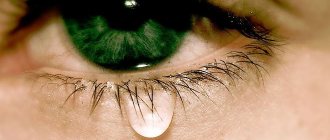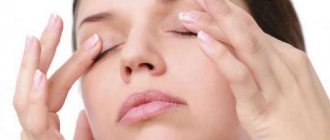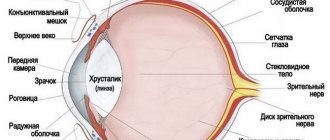Causes of burning eyes
Burning eyes can be caused by several factors and be a manifestation of various diseases:
- Infectious diseases. The etiology of infectious eye diseases can be any - bacterial, viral, fungal, parasitic. Most often, a burning sensation indicates that the patient has infectious conjunctivitis or blepharitis. Often, a burning sensation appears when the patient is ill with ARVI or influenza. Parasitic diseases include demodicosis - the reproduction of specific mites on the eyelids. It is very easy to become infected - just hold on to a handrail in the subway or on a bus that a sick person recently held on to, and then rub your eyes with dirty hands.
- Injuries. Mechanical damage to the eyes can be unnoticeable - simple dust or small specks getting into the eye.
- Burn. Burn injury can be thermal (from steam or boiling water getting into the eyes) or chemical (from chemicals such as detergent getting into the eyes).
- Eye strain. This reason is very common among people whose profession involves constant work on a computer. Despite the fact that modern monitors no longer require such eye strain as before, for many, such constant close “gazing” at the screen turns out to be excessive. Other such professions include constant work with a microscope, manipulation of small parts, and many others.
- Allergy. The manifestations of an allergic reaction to any substance are numerous and variable. One of the symptoms of an allergy may be a burning sensation in the eyes.
- Endocrine diseases. Some endocrine system disorders may be accompanied by redness of the eyelids and a burning sensation in the eyes, for example, with diseases of the thyroid gland.
- Dry eye syndrome. This syndrome is associated with impaired functioning of the lacrimal glands, which are responsible for the constant hydration of the conjunctiva. It manifests itself as a sensation of sand or debris getting into the eyes, a burning sensation.
- Incorrect refraction. Incorrectly prescribed glasses or contact lenses can lead to a burning sensation, pain in the eyes, and redness of the eyelids.
- Eye diseases. Among other symptoms of various serious ophthalmological diseases, there may be a burning sensation.
Treatment
Therapeutic measures to eliminate burning in the eyes are taken in accordance with the factors that caused this manifestation.
Ointments
As a rule, treatment with ointments is prescribed in the presence of infectious pathogens. The most effective are:
- Tetracycline. It has a small number of side effects and is recommended for use for burns, injuries or diseases caused by malignant bacteria.
- Levomycetin. It is an antibiotic drug that has a wide range of effects on microbes.
Drops
They are the most convenient preferred medications in the process of treating eye burning sensation. In this category of medicines it is worth noting:
- "Artificial tear". Prescribed for the “dry eye effect” in order to moisturize the mucous membrane of the visual organ. The medicine is instilled into the conjunctival sac. The treatment procedure involves drinking large amounts of fluid
- "Ophthalmoferon". The drops presented are suitable as a primary medication or as a preventive measure. The use of "Ophthalmoferon" is relevant for dry eye syndrome or in the presence of pathologies of viral origin
- "Tsipromed". The medicine can also be used as a prophylactic agent. However, more often it is prescribed for eye injuries or infectious provocateurs.
Folk remedies
Traditional medicine can help by offering a variety of compresses and lotions that help treat burning eyes.
- Chamomile lotions. For the purpose of their use, a decoction of chamomile is first made. Cotton pads soaked in the resulting mixture should be applied to the eyes in the morning and evening. In this case, the face should not be wearing cosmetics.
- Potato lotions. In this case, boiled potato halves in their jackets, previously cooled, are applied to closed eyelids. The procedure must be carried out before going to bed. This method helps not only relieve burning sensations, but also dark circles under the eyes
- Tea compresses. Two tea bags are doused with boiling water, after which, previously cooled, they are placed in the freezer for a short period of time. After a certain time, they are applied to both eyes. As a result, signs of fatigue and overstrain disappear
- Herbal compresses. Various herbs can be used here: mint, linden, calendula, aloe. To make compresses, a decoction is first made from these plants.
Treatment for burning eyes
Since a burning sensation in the eyes is not a disease itself, but only a symptom, a manifestation of other eye or general pathologies, the main treatment should be aimed at combating the main problem, and not so much at its manifestation. In any case, you cannot take this symptom lightly and carelessly. It is necessary to contact an ophthalmologist as soon as possible, who will check the eyes for the presence of foreign bodies, make a full diagnosis and prescribe specific treatment.
If an infection is present, specific antibacterial, antiviral, antifungal or antiparasitic therapy is prescribed, both general (tablets, injections) and local in the form of eye drops. Glaucoma and cataracts require treatment of the underlying disease; it will be useless to fight the burning sensation if the disease continues to progress. Dropping chamomile decoction into the eyes helps relieve inflammation.
For dry eyes, artificial tear drops are prescribed. During the day, the eyes need to be given periodic rest. To do this, it is enough to just sit for a few minutes with your eyes closed or go to the window and for a while just look into the distance, “beyond the horizon” without fixing your gaze on any specific object.
Incorrect refraction requires re-checking visual acuity and prescribing other glasses or contact lenses. Allergies are treated by prescribing antihistamines and antiallergic drugs.
For burns, soothing drops, anti-inflammatory and antibacterial medications are prescribed to prevent the development of complications. Diseases of the thyroid gland require specific treatment from an endocrinologist or therapist.
To relieve itching, burning in the eyes, and hyperemia of the eyelids, you can wash the eyes with decoctions of St. John's wort or oregano, or daisy juice. For inflammation of the eyelids, infusions of blueberries or barberries are used.
A proven method that can be used for any eye disease has long been known - rinsing with tea. The method is universal, well-proven and completely harmless. You can take already brewed bags and simply put them on your eyelids. Tea relieves irritation well, helps relieve inflammation, but is not therapeutic. It simply helps reduce the manifestations of the disease, but does not fight it.
On the subject: Vitamins for the eyes - which are the best?
Possible diseases and their treatment
Unpleasant sensations in the eye often indicate ophthalmological diseases. In addition to burning, itching, intolerance to bright light, lacrimation, spasms, serous and purulent discharge may appear.
Conjunctivitis is an inflammation of the conjunctival membrane when interacting with an irritant.
Due to the structural features of the eye, there is an increased availability of various allergens from the external environment, among which are:
- household – dust, mites, pillow feathers;
- epidermal - particles of animal epidermis;
- chemical – household chemicals, ;
- pollen - fluff, .
Symptoms include redness of the conjunctiva, lacrimation and burning. The main one is intense itching, which makes a person rub his eyes. Because of this, clinical manifestations often intensify.
Important! Inflammation of only one eyelid is not typical for allergic conjunctivitis.
The course can be acute or chronic. In the first case, the allergy begins suddenly and goes away just as quickly. In a chronic condition, a sluggish inflammatory process is noted.
If suspected, contact two specialists who deal with the problem - an ophthalmologist and an allergist. It is better to start the examination with an ophthalmologist, since the symptoms are similar to those of other diseases.
At the first signs, you should use corticosteroid drops and take an antihistamine. If the reaction is minor, you can use Visine.
Keratitis is a disease in which the cornea of the eye becomes inflamed. Characterized by redness, cloudiness, and pain. The disease can be of infectious or traumatic origin.
The patient experiences lacrimation, photophobia, the cornea loses its transparency and shine, becomes cloudy, and vision is impaired.
A reflex closure of the eyelids occurs - reflex blepharospasm. Often the patient feels the presence of a foreign object under the eyelid. Proper therapy in many cases guarantees a good result without loss of vision.
Keratitis is classified according to the type of inflammation of the layers of the cornea. When the inner layers are involved, they speak of deep keratitis. In case of inflammation of the superficial layers - about the superficial. The following types of keratitis are distinguished: bacterial, viral, fungal, photokeratitis, onchocerciasis, creeping corneal ulcer.
An ophthalmologist can treat redness and burning. The general principles of therapy are the local and systemic use of antiviral, antibacterial, and antifungal medications.
If keratitis is viral in nature, ointments and eye drops containing interferon are applied and immunomodulators are prescribed. For bacterial infections, antibacterial drops are prescribed, in some cases - a/b penicillin, cephalosporins, fluoroquinolones.
Blepharitis is a disease that is accompanied by inflammation of the ciliary edge of the eyelids. It is often long-term in nature with frequent relapses. In the diagnosis of the disease, a significant role is played by examination, testing of visual acuity, bacterial culture, and biomicroscopy.
Symptoms of blepharitis depend on the type:
- simple - densely exfoliated scales form around the eyes, the edges of the eyelids thicken;
- ulcerative - purulent discharge and ulcers form along the edge of the eyelids;
- seborrheic – the skin peels off and acquires a reddish tint, often the disease is combined with seborrhea of the scalp;
- allergic - the eyes begin to water, swelling, burning and intense itching appear;
- rosacea-blepharitis – small nodules appear that are combined with acne;
- demodicosis - accompanied by severe burning, pain and itching.
The cause of the disease in most cases is a staphylococcal infection.
With infectious blepharitis, discharge is formed, which leads to eyelashes sticking together and plaque formation. Non-infectious is often associated with uncorrected vision pathology.
Treatment is prescribed depending on the type of blepharitis. Combined ointments or drops (corticosteroids + antibiotics) are used.
Barley
Barley is an inflammatory disease of the eyelid. Characterized by the presence of a small nodule. Redness, burning and slight swelling are also noted. Barley usually forms inside the eyelid. It is often confused with a cyst and, because of this, the wrong treatment tactics are carried out.
The cause of barley formation is a bacterial infection and poor hygiene. In most cases, it goes away on its own and does not require complex treatment.
Important! Squeezing barley, cauterizing it with iodine and brilliant green is strictly not recommended.
Of the drugs you can use Ophthalmoferon drops. Dry heat (applied to the inflamed area) is also recommended. Compresses or washing the eyes with a warm chamomile decoction have a beneficial effect. An alternative is to brew green and black tea without additives or flavorings.
Waste products contribute to the development of rosacea on the face.
Main symptoms: swelling, burning, formation of scales and crusts along the eyelash line. Loss of eyelashes is often observed.
Treatment of demodicosis is prescribed by an ophthalmologist. It is usually long-term and takes about a month. This is due to the fact that the tick life cycle is long. They show an effect when taken systemically by Metronidazole and Tinidazole.
Local treatment of the inflamed area is no less important. First, pre-treat the crusts with tincture of eucalyptus and calendula. Afterwards special ointments are applied. Demalan ointment demonstrated a good effect in the etiotropic treatment of demodicosis.
Corticosteroids can be used to eliminate local toxicoallergic reactions. To avoid re-infection, it is important to follow the rules of personal hygiene.
Video from an expert:
Dry eye syndrome
Dry eye syndrome (DES) is a decrease or complete loss of the eye's ability to produce tears. Its symptoms are tingling and burning, redness of the eyelid. Often accompanied by minor itching.
The pathology is easily determined by an ophthalmologist based on complaints. The quality of tears also plays a significant role in the formation of the disease. Also, a decrease in tear production may be secondary - depending on the use of certain medications.
The burning sensation and other unpleasant symptoms can be eliminated only by solving the underlying problem. Treatment of pathology can be conservative or surgical. Conservative therapy includes taking eye drops for burning eyes and artificial tear substitutes.
The surgical method involves complete removal of the tear ducts or blocking the tear drainage pathways. Preventative measures also play a role. The patient should avoid situations that increase dryness. High temperatures, dry winds and dry vapors aggravate the situation.
Prevention for burning eyes
Preventive measures include timely contact with an ophthalmologist at the slightest suspicion of the development of ophthalmological diseases. It is recommended to undergo a medical examination by an ophthalmologist annually, especially for people who already have any visual impairment.
To prevent infection, it is necessary to carefully observe the rules of hygiene; you should not scratch or touch your eyes with unwashed hands.
If a foreign body gets into the eye, you need to ask someone to remove the speck from the eye using a cotton swab or the corner of a folded clean handkerchief. If the debris cannot be detected and removed, you should immediately seek emergency ophthalmological help.
Author of the article: Marina Vitalievna Degtyareva, ophthalmologist, ophthalmologist
Why do my eyes sting and water?
Lacrimation is a natural process, and tear fluid is constantly secreted in small quantities, which prevents the cornea from drying out and disinfects the eyes. Often discomfort in the eyes occurs if a person sits for a long time at a computer or TV. Dry indoor air and insufficient lighting can also cause this problem.
Let's determine why the eyes sting most often:
1. Allergic reaction. In this case, watery eyes and itching may be accompanied by redness and swelling of the eyes. The most common allergies are to pollen, food and cosmetics. In any case, you need to take antihistamines and see an allergist.
2. Infestation with mites (demodex of the eyelids). The disease occurs when using testers or someone else's mascara and shadows. To clarify the diagnosis, you should contact an ophthalmologist.
3. Reaction to household chemicals. It often stings the eyes when they are irritated by chemicals, shampoo, low-quality cosmetics, soap, etc. In this case, rinse your eyes with water, pat them dry with a clean towel and apply drops for irritation.
4. Eye diseases. Herpes, conjunctivitis and blepharitis (styes) can cause similar symptoms. In this case, as in the case of mechanical eye injury, you should urgently consult an ophthalmologist.
5. Sometimes it stings the eyes for quite serious reasons; it is necessary to undergo a comprehensive examination. The mucous membrane of the eyes dries out due to a lack of vitamin A, metabolic disorders and hormonal imbalances.
6. Some medications have side effects such as dry eyes and watery eyes. Inflammation of the lacrimal sac or blepharoptosis (weakening of the tone of the eye muscle), which occurs in older people, may require surgical intervention.
What to do if your eyes sting
First, remove your makeup and rinse your eyes thoroughly with water. If you wear contact lenses, change them regularly and give your eyes a break from them more often, and choose waterproof mascara. Do not let anyone else use your cosmetics and do not use them after the expiration date.
If you often work at a computer, look for time to do eye exercises or just sit for a few seconds with your eyes closed.
If your eyes sting, what else can you do:
Regularly ventilate the room and humidify the air;
Drink plain water (30 ml per 1 kg of body) to avoid drying out your eyes;
Apply chilled tea bags or cotton swabs with infusion of chamomile and other medicinal herbs to your eyes for 10-15 minutes.
And the last piece of advice: if your eyes are prone to irritation, then carry special eye drops in your bag and consult an ophthalmologist. And then the situation described above will not take you by surprise.
Almost every person has experienced burning and itching in the eyes.
Sometimes the causes are external factors, in other cases – various diseases.
If such a symptom appears, it is necessary to begin proper treatment.











